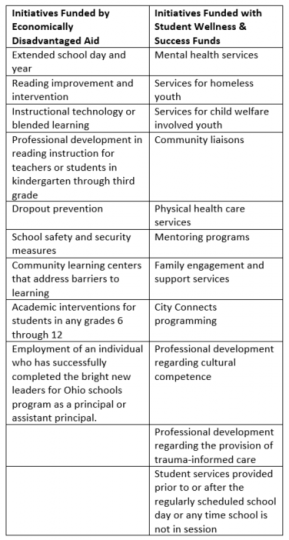
Ohio Must Support Student Wellness and Education Equity: Creating False Choices Hurts Children and Ohio’s Future
May 28, 2021
By Alison Paxson, Communications & Policy Associate
Placing Student Wellness and Success Funds (SWSF) in the Disadvantaged Pupil Impact Aid (DPIA) with Economically Disadvantaged funds in the school funding formula pits the specific purposes of these funds against each other. It makes funding for child health compete against funding for child educational supports – but we know this is never in the interest of supporting opportunities for our children to learn and thrive.
When it comes to the wellbeing of our children, the conversation is never an “either/or” scenario. It must be an “and”.
Ohio has the responsibility to create an equitable school funding system that meets the diverse needs of all learners in our state.
Last month, the Ohio House passed budget bill included the Fair School Funding Plan, a plan that accounts for the financial capacity of 610 different school districts and the needs of 1.6 million children. This plan was developed by educators, superintendents, treasurers, and school funding experts over three years through a collaborative and transparent process using the best research available. If passed, this plan would strengthen our system of public education by reducing reliance on local property taxes in the funding formula, which has contributed to disparities in educational opportunity for decades. We applaud our House leadership for championing this plan to fully and fairly fund Ohio’s schools.
 But, in addition to our responsibility to ensure school funding opportunity for all children, Ohio must also meet the mental, behavioral, and social-emotional needs of school children so they are healthy and ready to learn as part of our commitment to Ohio’s Whole Child Framework and Each Child, Our Future. Even prior to the pandemic, we know that more than 550,000 Ohio children and adolescents had a behavioral health condition, demonstrating just how pervasive these challenges are among children and how high the need could now be given that child mental and behavioral health issues have surged amid the instability of the pandemic.
But, in addition to our responsibility to ensure school funding opportunity for all children, Ohio must also meet the mental, behavioral, and social-emotional needs of school children so they are healthy and ready to learn as part of our commitment to Ohio’s Whole Child Framework and Each Child, Our Future. Even prior to the pandemic, we know that more than 550,000 Ohio children and adolescents had a behavioral health condition, demonstrating just how pervasive these challenges are among children and how high the need could now be given that child mental and behavioral health issues have surged amid the instability of the pandemic.
Fortunately, Student Wellness and Success Funds were appropriated during the last biennial budget to assist schools in providing their students with mental health counseling, wraparound services, mentoring opportunities, and other initiatives to support whole child physical, social, emotional, and intellectual wellbeing. Even better is that the Governor’s Executive Budget for FY22-23 proposed to increase these funds by $100 million per fiscal year, recognizing the impending child mental health crisis that some have even called the “next ‘wave’ of the pandemic”.
Unfortunately, the Ohio House budget amended the Governor’s executive budget by inserting the Student Wellness and Success Funds into the Fair School Funding Plan, combining these dollars with Economically Disadvantaged funds into the Disadvantaged Pupil Impact Aid (DPIA) component. This raises several concerns.
First, rolling Student Wellness and Success Funds into the DPIA will make it so that dollars for Student Wellness and Success Funds – which have the intended purpose of addressing social, emotional, and behavioral health – will now be distributed based on the number of students who qualify for free or reduced-priced lunch. If these funds were to remain outside of the formula, as originally created in the last budget process, each school would receive a base funding allocation plus an additional tiered per pupil payment based on the federal poverty index. This means fewer Ohio schools will be able to benefit from supports and services these funds are intended to provide for all children.
Essentially, what this does, is perpetuate the stigma that social-emotional learning and behavioral and mental health challenges are concentrated among students living in families and communities who are low-income. But, of course, all children, regardless of income, benefit from learning how to form positive, healthy relationships, navigating and mitigating conflict, managing difficult emotions, and other social behaviors that social-emotional learning can help refine to improve long-term child health and wellbeing. In fact, a 2021 national poll found that 73% of parents reported that COVID-19 has had a very or somewhat negative impact on their teen’s ability to interact with their friends, and 46% said they have noticed a new or worsening mental health condition for their teen since the start of the pandemic. It is critical that SWSF are allocated at a base amount to all Ohio districts so all Ohio children can benefit while also, of course, considering the federal poverty index to account for equity.
 Secondly, this combination reduces overall funding for both Student Wellness and Success Funds and Economically Disadvantaged funds by $180 million. Currently, both SWSF and Economically Disadvantaged aid are funded at approximately $400 million each for FY21. However, the House’s proposed appropriation for the DPIA is $620 million – representing a reduction in funding for both critically important areas.
Secondly, this combination reduces overall funding for both Student Wellness and Success Funds and Economically Disadvantaged funds by $180 million. Currently, both SWSF and Economically Disadvantaged aid are funded at approximately $400 million each for FY21. However, the House’s proposed appropriation for the DPIA is $620 million – representing a reduction in funding for both critically important areas.
This means that the DPIA’s appropriated amount of $620 million will now have to stretch to cover all the initiatives funded by both pieces of aid (see chart) with less overall dollars.
Beyond the initiatives listed to the left, the bill dictates that the following should also be covered by the DPIA:
- Reduced class size;
- One year of quality preschool for every child who is four years of age and identified as economically disadvantaged.
According to a report from the Ohio Education Policy institute, the number of economically disadvantaged students in Ohio increased by 66.7% between FY01 and FY18 – the amount of economically disadvantaged aid to support these students increased by just 22.7%.
One reason passing the Fair School Funding Plan is so important is because it would critically increase the economically disadvantaged student aid base amount from $272 to $422 per pupil – but this is still an arbitrary number because Ohio has never conducted a study to determine the true cost of educating economically disadvantaged students. While this, too, will be addressed by the Fair School Funding Plan, the argument remains that the DPIA money for its currently defined purpose is still too low to address economic disadvantage and the mental and behavioral health needs of children.
Finally, another concern is that there is no guarantee that Student Wellness and Success Funds within the DPIA in the school funding formula will be used by districts for their intended purpose to target the mental and behavioral health needs of children. When combined within the DPIA along with Economically Disadvantaged Aid, as outlined in the table above, there are many different initiatives that these funds can flexibly be used for. This flexibility is good – school districts should have the ability to choose what initiatives work best to fit the needs of their unique student and community populations. But it does not guarantee that we will meet the increased needs children have right now for social-emotional and behavioral health care, thereby diluting the promise of these funds as landmark upstream investments in child health.
Ohio’s final budget must include:
- The Governor’s executive budget language and funding for Student Wellness and Success; AND
- The Ohio House’s budget provisions for funding and phase-in of the Fair School Funding Plan.
Ohio has the resources and responsibility to do both.
Photo by Jeswin Thomas on Unsplash

